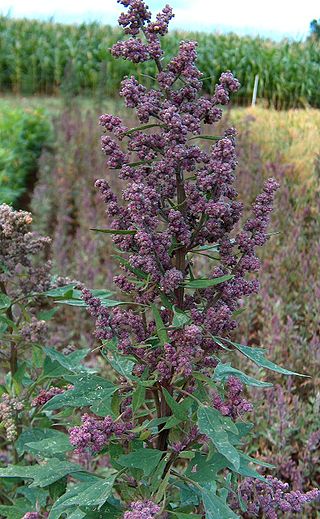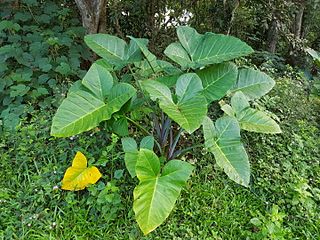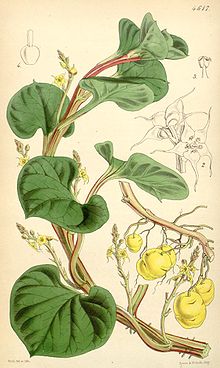
The potato is a starchy tuberous vegetable native to the Americas that is consumed as a staple food in many parts of the world. Potatoes are underground tubers of the plant Solanum tuberosum, a perennial in the nightshade family Solanaceae.

Quinoa is a flowering plant in the amaranth family. It is a herbaceous annual plant grown as a crop primarily for its edible seeds; the seeds are rich in protein, dietary fiber, B vitamins and dietary minerals in amounts greater than in many grains. Quinoa is not a grass but rather a pseudocereal botanically related to spinach and amaranth, and originated in the Andean region of northwestern South America. It was first used to feed livestock 5,200–7,000 years ago, and for human consumption 3,000–4,000 years ago in the Lake Titicaca basin of Peru and Bolivia.

Oxalis tuberosa is a perennial herbaceous plant that overwinters as underground stem tubers. These tubers are known as uqa in Quechua, oca in Spanish, yams in New Zealand and several other alternative names. The plant was brought into cultivation in the central and southern Andes for its tubers, which are used as a root vegetable. The plant is not known in the wild, but populations of wild Oxalis species that bear smaller tubers are known from four areas of the central Andean region. Oca was introduced to Europe in 1830 as a competitor to the potato, and to New Zealand as early as 1860.

The Jerusalem artichoke, also called sunroot, sunchoke, wild sunflower, topinambur, or earth apple, is a species of sunflower native to central North America. It is cultivated widely across the temperate zone for its tuber, which is used as a root vegetable.

Salvia hispanica, one of several related species commonly known as chia, is a species of flowering plant in the mint family, Lamiaceae, native to central and southern Mexico and Guatemala. It is considered a pseudocereal, cultivated for its edible, hydrophilic chia seed, grown and commonly used as food in several countries of western South America, western Mexico, and the southwestern United States.

The yacón is a species of daisy traditionally grown in the northern and central Andes from Colombia to northern Argentina for its crisp, sweet-tasting, tuberous roots. Their texture and flavour are very similar to jícama, mainly differing in that yacón has some slightly sweet, resinous, and floral undertones to its flavour, probably due to the presence of inulin, which produces the sweet taste of the roots of elecampane, as well. Another name for yacón is Peruvian ground apple, possibly from the French name of potato, pomme de terre. The tuber is composed mostly of water and various polysaccharides.

Tropaeolum tuberosum is a species of flowering plant in the family Tropaeolaceae, grown in the Andes, particularly in Peru and Bolivia, and to a lesser extent in Ecuador as well as in some areas of Colombia, for its edible tubers, which are eaten cooked or roasted as a vegetable. It is a minor food source, especially for native Amerindian populations. Mashua is a herbaceous perennial climber growing to 2–4 m (7–13 ft) in height. It is related to garden nasturtiums, and is occasionally cultivated as an ornamental for its brightly coloured tubular flowers.

Lupinus mutabilis is a species of lupin grown in the Andes, mainly for its edible bean. Vernacular names include tarwi, chocho, altramuz, Andean lupin, South American lupin, Peruvian field lupin, and pearl lupin. Its nutrient-rich seeds are high in protein, as well as a good source for cooking oil. However, their bitter taste has made L. mutabilis relatively unknown outside the Andes, though modern technology makes removing the bitter alkaloids easier. Like other species of lupin beans, it is expanding in use as a plant-based protein source.
Mirabilis expansa is a species of flowering plant cultivated as a root vegetable in the Andes, at cold, windy altitudes between 2,200 m (7,200 ft) and 3,500 m (11,500 ft). The above-ground portion dies back with frost, but the root is quite hardy. The roots can reach the size of a man's forearm, and yields can reach 50,000 kg/ha (45,000 lb/acre) given two years maturation time.

Lathyrus tuberosus is a small, climbing perennial plant, native in moist temperate parts of Europe and Western Asia. The plant is a trailer or weak climber, supported by tendrils, growing to 1.2 m tall. The leaves are pinnate, with two leaflets and a branched twining tendril at the apex of the petiole. Its flowers are hermaphroditic, pollinated by bees. The plants can also spread vegetatively from the root system.

Chia seeds are the edible seeds of Salvia hispanica, a flowering plant in the mint family (Lamiaceae) native to central and southern Mexico, or of the related Salvia columbariae, Salvia polystachia, or Salvia tiliifolia. Chia seeds are oval and gray with black and white spots, having a diameter of around 2 millimetres (0.08 in). The seeds are hygroscopic, absorbing up to 12 times their weight in liquid when soaked and developing a mucilaginous coating that gives chia-based foods and beverages a distinctive gel texture.

Amaranthus caudatus is a species of annual flowering plant. It goes by common names such as love-lies-bleeding, pendant amaranth, tassel flower, velvet flower, foxtail amaranth, and quelite.

Pachyrhizus erosus, commonly known as jícama or Mexican turnip, is a native Mesoamerican vine, although the name jícama most commonly refers to the plant's edible tuberous root. It is in the pea family (Fabaceae). Pachyrhizus tuberosus and Pachyrhizus ahipa are the other two cultivated species in the genus. The naming of this group of edible plants can sometimes be confusing, with much overlap of similar or the same common names.

Yam is the common name for some plant species in the genus Dioscorea that form edible tubers.

Xanthosoma sagittifolium, or tannia, is a tropical flowering plant from the family Araceae. It produces an edible, starchy corm. X. sagittifolium is native to tropical America where it has been first cultivated. Around the 19th century, the plant spread to Southeast Asia and Africa and has been cultivated there ever since. X. sagittifolium is often confused with the related plant Colocasia esculenta (Taro), which looks very similar and is also used in a similar way. Both plants are often collectively named Cocoyam.

Pachyrhizus ahipa, also called the ahipa or Andean yam bean, is a tuberous root-producing legume, which is distributed mainly in the Andean region.

Olluquito, olluquito con carne and olluquito con ch'arki are traditional dishes in Peruvian cuisine made with ulluku a root vegetable that also has edible leaves. It is an important root crop in the Andean region of South America, second only to the potato. The leaf and the tuber are edible; the leaves are similar to spinach, and the root is like a potato or jicama. The Ulluku contains high levels of protein, calcium, and carotene. Papalisa were used by the Incas prior to arrival of Europeans in South America. It can be served with meat.

A staple food, food staple, or simply staple, is a food that is eaten often and in such quantities that it constitutes a dominant portion of a standard diet for an individual or a population group, supplying a large fraction of energy needs and generally forming a significant proportion of the intake of other nutrients as well. For humans, a staple food of a specific society may be eaten as often as every day or every meal, and most people live on a diet based on just a small variety of food staples. Specific staples vary from place to place, but typically are inexpensive or readily available foods that supply one or more of the macronutrients and micronutrients needed for survival and health: carbohydrates, proteins, fats, minerals, and vitamins. Typical examples include grains, seeds, nuts and root vegetables. Among them, cereals, legumes and tubers account for about 90% of the world's food calorie intake.

Current agricultural practices of the Andean region of South America typically involve a synthesis of traditional Incan practices and modern techniques to deal with the unique terrain and climatic elements of the area. Millions of farmers in economically impoverished communities make a living producing staple crops such as potato, olluco, and mashua for their own consumption as well as profit in local and urban markets. The Andean region is particularly known for its wide variety of potato species, boasting over about 5,000 varieties identified by the International Potato Center based in Peru. These crops are arranged within the mountains and plateaus of the Andes in four distinct landscape-based units described as Hill, Ox Area, Early Planting, and Valley which overlap one another in a patchwork-styles of plateau surfaces, steep slopes, and wetland patches. Within each of these units, farmers classify soil types as either puna or suni.

Viral diseases of potato are a group of diseases caused by different types of Viruses that affect potato crops worldwide and, although they do not affect human or animal health since they are viruses that only infect vegetables, they are a source of great economic losses annually. About 28 viruses have been reported infecting potato crops. However, potato virus X (PVX), potato virus Y (PVY), and potato leafroll virus (PLRV) are the most important viruses worldwide. Some others are of economic importance only in some regions. Such is the case of potato virus M (PVM) in some Asian and European countries.





















